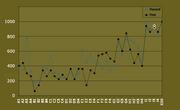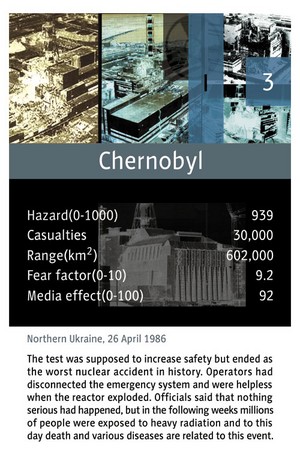|

On 26 April 1986 there was a major accident at the Chernobyl nuclear power plant in northern Ukraine.
The accident was paradoxical, because it occurred during a safety test. As technicians deliberately disconnected the reactor�s automatic shutdown devices the heat within the reactor began to rise rapidly.
This resulted in two disastrous explosions, which destroyed the reactor core and dispersed radioactive material throughout the area. In spite of the efforts of local firefighters, of whom many later died of radiation, fires were not extinguished until 10 days later.
The extended duration of the fires, which caused a massive release of radioactive material, was one of the main reasons why Chernobyl became the worst nuclear accident in history. Not only did the dispersal go on for 10 days, but a change in rainfall and wind direction caused the radioactive material to spread to a very large area, including Ukraine, Belarus and parts of Russia.
A total of 50 tons of radioactive dust were dispersed over 400,000 square kilometers and an estimated 4.9 million people were exposed.
People were exposed to radiation both externally and internally through the ingestion of agricultural products such as milk.
In the following years, there was a significant increase in childhood cancer as well as newborn cripples. It is not clear, though, what the long-term health effects of the accident are.
As a result of the accident, USA and the former USSR signed a "Memorandum of Cooperation in the Field of Civilian Nuclear Reactor Safety" in order to study the effects of nuclear accidents. The Chernobyl plant has been shut down and entombed in a concrete sarcophagus.
Comment this page
 
Links and references:
According to BBC the United Nations said in 2001 that the number is 15.000-30.000, see:
http://news.bbc.co.uk/1/hi/world/europe/1952437.st...
and:
http://news.bbc.co.uk/1/hi/world/europe/722533.stm
And a recent and comprehensive treatment of the accident, see:
http://R.F. Mould: Chernobyl Record � The Definiti...
Discussions about the death toll, see:
http://NY Times states on Fri, 14 Apr 95 that the ...
An analysis of the counterproductive safety improvements, see:
http://R.F. Mould: Chernobyl Record � The Definiti...
Information about affected countries and known consequences:
http://www.chernobyl.info/en/Facts/Countries
For information about the long road to recovery, see:
http://www.unu.edu/unupress/unupbooks/uu21le/uu21l...
or at:
http://www.chernobyl.com/info.htm
Read about the accident at the World Nuclear Organization website:
http://www.world-nuclear.org/info/chernobyl/inf07a...
A good learning site:
http://library.thinkquest.org/3426/
|



